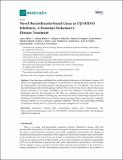Files in this item
Novel benzothiazole-based ureas as 17β-HSD10 inhibitors, a potential Alzheimer’s disease treatment
Item metadata
| dc.contributor.author | Aitken, Laura | |
| dc.contributor.author | Benek, Ondrej | |
| dc.contributor.author | McKelvie, Brogan | |
| dc.contributor.author | Hughes, Rebecca E. | |
| dc.contributor.author | Hroch, Lukas | |
| dc.contributor.author | Schmidt, Monika | |
| dc.contributor.author | Major, Louise L | |
| dc.contributor.author | Vinklarova, Lucie | |
| dc.contributor.author | Kuca, Kamil | |
| dc.contributor.author | Smith, Terry K | |
| dc.contributor.author | Musilek, Kamil | |
| dc.contributor.author | Gunn-Moore, Frank J | |
| dc.date.accessioned | 2019-07-30T08:30:04Z | |
| dc.date.available | 2019-07-30T08:30:04Z | |
| dc.date.issued | 2019-07-29 | |
| dc.identifier.citation | Aitken , L , Benek , O , McKelvie , B , Hughes , R E , Hroch , L , Schmidt , M , Major , L L , Vinklarova , L , Kuca , K , Smith , T K , Musilek , K & Gunn-Moore , F J 2019 , ' Novel benzothiazole-based ureas as 17β-HSD10 inhibitors, a potential Alzheimer’s disease treatment ' , Molecules , vol. 24 , no. 15 , 2757 . https://doi.org/10.3390/molecules24152757 | en |
| dc.identifier.issn | 1420-3049 | |
| dc.identifier.other | PURE: 260299059 | |
| dc.identifier.other | PURE UUID: d4b2522b-c8b3-4f58-8d49-afda62a22d5a | |
| dc.identifier.other | ORCID: /0000-0001-5287-4488/work/60195453 | |
| dc.identifier.other | ORCID: /0000-0003-3422-3387/work/60195495 | |
| dc.identifier.other | ORCID: /0000-0001-7259-4491/work/60195924 | |
| dc.identifier.other | WOS: 000482441100080 | |
| dc.identifier.other | Scopus: 85070791027 | |
| dc.identifier.uri | https://hdl.handle.net/10023/18200 | |
| dc.description | Funding: This work was supported by Alzheimer’s Society (specifically The Barcopel Foundation), Scottish Universities Life Science Alliance (SULSA), The Rosetrees Trust, WT-ISSF and RS MacDonald Charitable Trust, Ministry of Education, Youth and Sports of Czech Republic (project ESF no. CZ.02.1.01/0.0/0.0/18_069/0010054), and University of Hradec Kralove (Faculty of Science, no. VT2019-2021, SV2115-2018, and Postdoctoral job positions at UHK). | en |
| dc.description.abstract | It has long been established, that mitochondrial dysfunction in Alzheimer’s disease (AD) patients can trigger pathological changes in cell metabolism by altering metabolic enzymes such as the mitochondrial 17β-hydroxysteroid dehydrogenase type 10 (17β-HSD10) also known as amyloid-binding alcohol dehydrogenase (ABAD). We and others have shown that frentizole and riluzole derivatives can inhibit 17β-HSD10 and that this inhibition is beneficial and holds therapeutic merit for the treatment of AD. Here we evaluate several novel series based on benzothiazolylurea scaffold evaluating key structural and activity relationships required for the inhibition of 17β-HSD10. Results show that the most promising of these compounds have markedly increased potency on our previously published inhibitors, with the most promising exhibiting advantageous features like low cytotoxicity and target engagement in living cells. | |
| dc.language.iso | eng | |
| dc.relation.ispartof | Molecules | en |
| dc.rights | © 2019 by the authors. Licensee MDPI, Basel, Switzerland. This article is an open access article distributed under the terms and conditions of the Creative Commons Attribution (CC BY) license (http://creativecommons.org/licenses/by/4.0/). | en |
| dc.subject | Alzheimer's disease (AD) | en |
| dc.subject | Amyloid-beta peptide (Aβ) | en |
| dc.subject | Mitochondria | en |
| dc.subject | Amyloid binding alcohol dehydrogenase (ABAD) | en |
| dc.subject | 17β-Hydroxysteroid dehydrogenase type 10 (17β-HSD10) | en |
| dc.subject | Benzothiazole | en |
| dc.subject | QD Chemistry | en |
| dc.subject | QH301 Biology | en |
| dc.subject | RC0321 Neuroscience. Biological psychiatry. Neuropsychiatry | en |
| dc.subject | DAS | en |
| dc.subject.lcc | QD | en |
| dc.subject.lcc | QH301 | en |
| dc.subject.lcc | RC0321 | en |
| dc.title | Novel benzothiazole-based ureas as 17β-HSD10 inhibitors, a potential Alzheimer’s disease treatment | en |
| dc.type | Journal article | en |
| dc.contributor.sponsor | The Wellcome Trust | en |
| dc.description.version | Publisher PDF | en |
| dc.contributor.institution | University of St Andrews. School of Biology | en |
| dc.contributor.institution | University of St Andrews. Biomedical Sciences Research Complex | en |
| dc.contributor.institution | University of St Andrews. Sir James Mackenzie Institute for Early Diagnosis | en |
| dc.contributor.institution | University of St Andrews. Centre for Biophotonics | en |
| dc.contributor.institution | University of St Andrews. Institute of Behavioural and Neural Sciences | en |
| dc.identifier.doi | https://doi.org/10.3390/molecules24152757 | |
| dc.description.status | Peer reviewed | en |
| dc.identifier.grantnumber | 097831/z/11/z | en |
This item appears in the following Collection(s)
Items in the St Andrews Research Repository are protected by copyright, with all rights reserved, unless otherwise indicated.

